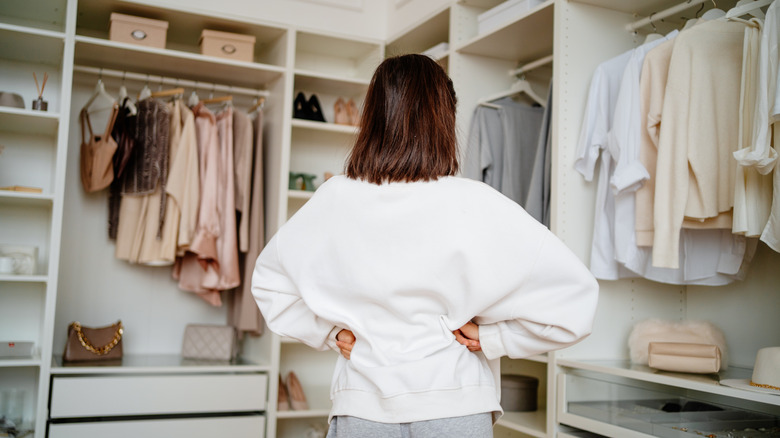The Clever Closet Organizer That Makes The Most Of Vertical Space
We may receive a commission on purchases made from links.
Self-storage facilities saw a huge boost in usage amid pandemic lockdowns, with individual American households making up a giant portion of that drive for more storage space, which often comes at a premium price. If you're looking to save some money on storage, however, consider turning to your own closet space. There are plenty of closet organizer ideas out there, but if you have a lot of vertical space the best option may just be stacking rows of floating shelves.
A floating shelf, one that's attached to the wall with hidden mounts for a seamless, sleek look, is often used for displaying a piece of artwork or a collectible item. However, use enough of them at scale and you can give your closet space the appearance and functionality of a warehouse backroom — or at least, that's the premise of a DIY project idea uploaded to TikTok by @thenavagepatch.
Their vertical closet retrofit with L-shaped shelves is more work than the average crafty DIY endeavor of reusing cardboard boxes for a DIY stylish storage solution, for example, but it can absolutely help you get the most out of your home's limited space so there's less to organize in off-site self-storage facilities. Purses, shoes, and small clothing items could be stored on these floating shelves in your closet.
Maximize your vertical closet with floating shelf organization
To start off this closet overhaul, you'll first want to strip the room bare, make your wall's nail holes disappear if there are any, and paint the whole thing over in whatever color you desire. The original TikTok uses plywood and pine wood to construct new shelves, but if you have more experience with or easier access to different types of lumber, there's nothing to say you can't work with other strong, lightweight materials such as basswood or balsa wood.
Regardless, begin to build your shelves by setting a frame of short, rectangular wood (in the video, it's pine) around all four walls. Two walls should have the entire length covered, while the other two "edge" sides should only extend as far onto the walls as your shelves will go. You can build as many rows of shelves up vertically as you deem necessary, with as much space between each shelf as you want to store objects.
From there, build out the frames from top to bottom, using pocket screws to hold together ladder-shaped rungs of pine that create double floating shelves for your closet. The tops of each shelf frame can be set with sheets of plywood, whereas the bottoms and front faces of each shelf can be covered using ⅛-inch utility panels, secured using construction adhesive and nails before all the seams are sealed with all-purpose wood filler and caulk. After that you can paint and decorate to your hearts' desire, making a cohesive vertical space to organize all of your daily needs.
